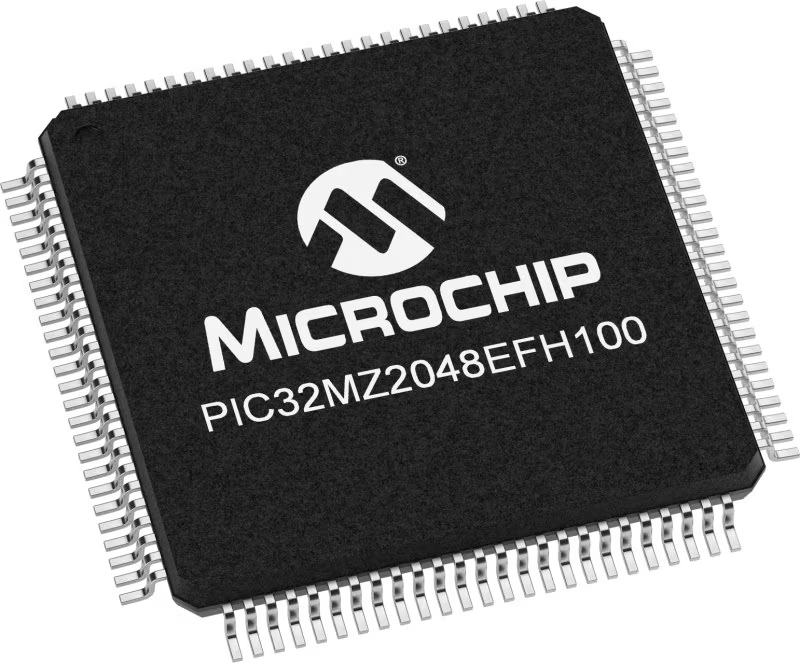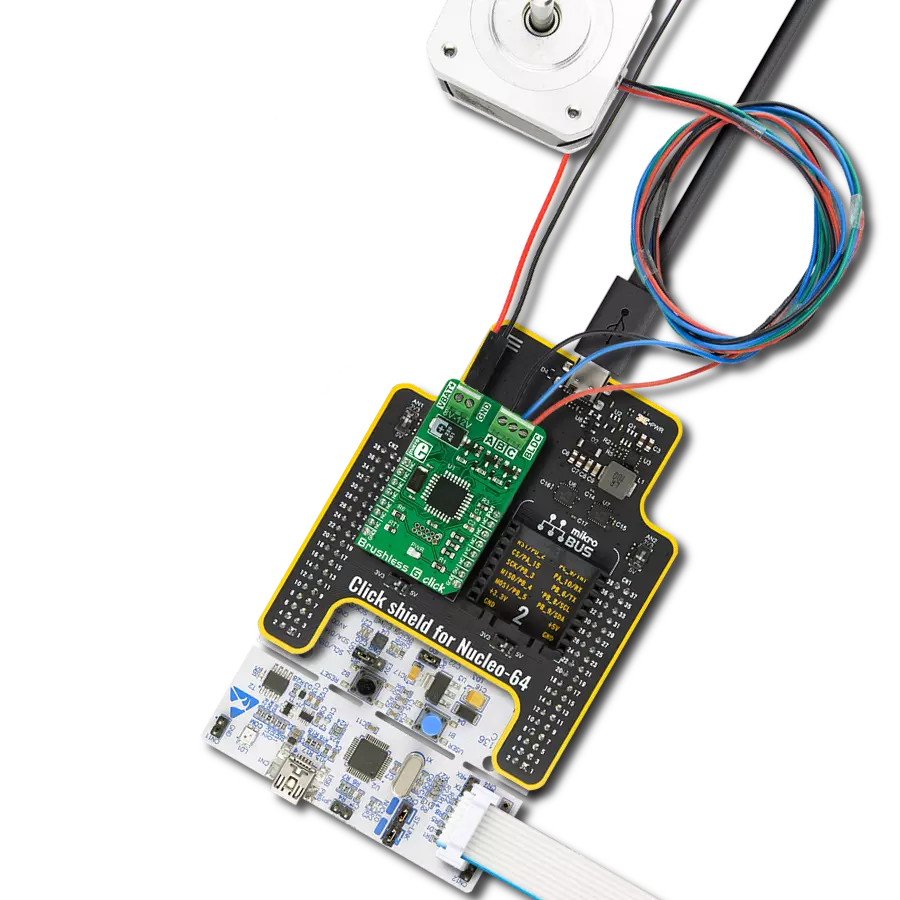Empower robotics, drones, and automation applications with reliable and efficient motion control
A
A
Hardware Overview
How does it work?
Brushless Click is based on the TB6575FNG, a PWM sensorless controller for three-phase full-wave BLDC from Toshiba Semiconductor. It is based on the PWM chopper drive. After receiving an analog voltage command input, the rotor is aligned to a known position, and then the rotation is started in a forced commutation mode, thus acquiring the back-EMF. To drive a BLDC motor in a sensorless drive, a signal is generated based on the back-EMF sensing as a natural commutation PWM signal. This natural commutation PWM is automatically switched from the forced Commutation PWM signal when a polarity signal of each phase voltage (including the back-EMF) is applied to the position signal input. Two types of MOSFET chips onboard switch the output ON and OFF. This controls the voltage levels applied to the motor, determining the motor shaft's speed and rotation. These are the Si4497, a P-channel 30V MOSFET, and the Si4154, an N-channel 40V MOSFET from Vishay. Brushless click is
theoretically capable of outputting higher currents; however, in such a case, the MOSFET chips have to be cooled down with an external cooler. To connect an external DC power supply, there is a VBAT screw terminal. The screw terminal labeled BLDC (GND, U, V, W) is for connecting phases of an external motor. As a position sensing input of the TB6575FNG, this Click board™ uses the LM2903, a low-power dual voltage comparator from STMicroelectronics. For sensing purposes, this comparator uses voltages of all motor driver outputs. For a duty cycle control input, this Click board™ uses the MCP6281, a rail-to-rail operational amplifier from Microchip. This OpAmp as input uses a PWM signal from the mikroBUS™ socket. Brushless Click uses only a PWM signal as a connection with the host MCU over the mikroBUS™ socket. The signal is supplied to the WAVE position sensing input of the motor driver through the operational amplifier. The rotation speed sensing output is monitored over the INT
pin of the mikroBUS™ socket. To set the rotation direction, you can use logic HIGH and LOW states on the DIR pin, HIGH for reverse, and LOW for forward rotation. The VSN pin over the resistor divider can monitor the battery voltage. Position detection is synchronized with the PWM signal generated in the IC. A position detection error relative to the PWM frequency may occur when the IC is used in a high-speed motor. The detection is performed on the falling edge of the PWM signal. An error is recognized when the pin voltage exceeds the reference voltage. This Click board™ can be operated only with a 5V logic voltage level. The board must perform appropriate logic voltage level conversion before using MCUs with different logic levels. It comes equipped with a library containing functions and an example code that can be used, as a reference, for further development.
Features overview
Development board
Flip&Click PIC32MZ is a compact development board designed as a complete solution that brings the flexibility of add-on Click boards™ to your favorite microcontroller, making it a perfect starter kit for implementing your ideas. It comes with an onboard 32-bit PIC32MZ microcontroller, the PIC32MZ2048EFH100 from Microchip, four mikroBUS™ sockets for Click board™ connectivity, two USB connectors, LED indicators, buttons, debugger/programmer connectors, and two headers compatible with Arduino-UNO pinout. Thanks to innovative manufacturing technology,
it allows you to build gadgets with unique functionalities and features quickly. Each part of the Flip&Click PIC32MZ development kit contains the components necessary for the most efficient operation of the same board. In addition, there is the possibility of choosing the Flip&Click PIC32MZ programming method, using the chipKIT bootloader (Arduino-style development environment) or our USB HID bootloader using mikroC, mikroBasic, and mikroPascal for PIC32. This kit includes a clean and regulated power supply block through the USB Type-C (USB-C) connector. All communication
methods that mikroBUS™ itself supports are on this board, including the well-established mikroBUS™ socket, user-configurable buttons, and LED indicators. Flip&Click PIC32MZ development kit allows you to create a new application in minutes. Natively supported by Mikroe software tools, it covers many aspects of prototyping thanks to a considerable number of different Click boards™ (over a thousand boards), the number of which is growing every day.
Microcontroller Overview
MCU Card / MCU

Architecture
PIC32
MCU Memory (KB)
2048
Silicon Vendor
Microchip
Pin count
100
RAM (Bytes)
524288
You complete me!
Accessories
Brushless DC (BLDC) Motor with a Hall sensor represents a high-performance motor from the 42BLF motor series. This motor, wired in a star configuration, boasts a Hall Effect angle of 120°, ensuring precise and reliable performance. With a compact motor length of 47mm and a lightweight design tipping the scales at just 0.29kg, this BLDC motor is engineered to meet your needs. Operating flawlessly at a voltage rating of 24VDC and a speed range of 4000 ± 10% RPM, this motor offers consistent and dependable power. It excels in a normal operational temperature range from -20 to +50°C, maintaining efficiency with a rated current of 1.9A. Also, this product seamlessly integrates with all Brushless Click boards™ and those that require BLDC motors with Hall sensors.
Used MCU Pins
mikroBUS™ mapper
Take a closer look
Click board™ Schematic

Step by step
Project assembly
Track your results in real time
Application Output
1. Application Output - In Debug mode, the 'Application Output' window enables real-time data monitoring, offering direct insight into execution results. Ensure proper data display by configuring the environment correctly using the provided tutorial.

2. UART Terminal - Use the UART Terminal to monitor data transmission via a USB to UART converter, allowing direct communication between the Click board™ and your development system. Configure the baud rate and other serial settings according to your project's requirements to ensure proper functionality. For step-by-step setup instructions, refer to the provided tutorial.

3. Plot Output - The Plot feature offers a powerful way to visualize real-time sensor data, enabling trend analysis, debugging, and comparison of multiple data points. To set it up correctly, follow the provided tutorial, which includes a step-by-step example of using the Plot feature to display Click board™ readings. To use the Plot feature in your code, use the function: plot(*insert_graph_name*, variable_name);. This is a general format, and it is up to the user to replace 'insert_graph_name' with the actual graph name and 'variable_name' with the parameter to be displayed.

Software Support
Library Description
This library contains API for Brushless Click driver.
Key functions:
brushless_spin_clockwise- This function sets the spin direction of the motor to clockwisebrushless_spin_counter_clockwise-This function sets the spin direction of the motor to counter clockwisebrushless_read_rotation_speed_sensor_output- This function reads the digital input of the INT pin
Open Source
Code example
The complete application code and a ready-to-use project are available through the NECTO Studio Package Manager for direct installation in the NECTO Studio. The application code can also be found on the MIKROE GitHub account.
/*!
* \file
* \brief Brushless Click example
*
* # Description
* This example showcases how to initialize and use the Brushless Click.
* The Click has a brushless motor driver which controls the work
* of the motor through the BLDC terminal.
* In order for this example to work a motor and a power supply are needed.
*
* The demo application is composed of two sections :
*
* ## Application Init
* This function initializes and configures the logger and Click modules.
*
* ## Application Task
* This is an example that demonstrates the use of a Brushless Click board.
* Brushless Click communicates with the register via the PWM interface.
* It shows moving in the left direction from slow to fast speed
* and from fast to slow speed.
* Results are being sent to the Usart Terminal where you can track their changes.
*
* \author Nikola Peric
*
*/
// ------------------------------------------------------------------- INCLUDES
#include "board.h"
#include "log.h"
#include "brushless.h"
// ------------------------------------------------------------------ VARIABLES
static brushless_t brushless;
static log_t logger;
uint8_t brushless_direction = 1;
// ------------------------------------------------------ APPLICATION FUNCTIONS
void application_init ( )
{
log_cfg_t log_cfg;
brushless_cfg_t cfg;
/**
* Logger initialization.
* Default baud rate: 115200
* Default log level: LOG_LEVEL_DEBUG
* @note If USB_UART_RX and USB_UART_TX
* are defined as HAL_PIN_NC, you will
* need to define them manually for log to work.
* See @b LOG_MAP_USB_UART macro definition for detailed explanation.
*/
LOG_MAP_USB_UART( log_cfg );
log_init( &logger, &log_cfg );
log_info( &logger, "---- Application Init ----" );
Delay_ms ( 100 );
// Click initialization.
brushless_cfg_setup( &cfg );
BRUSHLESS_MAP_MIKROBUS( cfg, MIKROBUS_1 );
Delay_ms ( 100 );
brushless_init( &brushless, &cfg );
brushless_pwm_start( &brushless );
log_info( &logger, "---- Application Task ----" );
Delay_ms ( 1000 );
}
void application_task ( )
{
static int8_t duty_cnt = 1;
static int8_t duty_inc = 1;
float duty = duty_cnt / 10.0;
if ( brushless_direction == 1 )
{
brushless_spin_clockwise ( &brushless );
log_printf( &logger, "<<<< " );
}
else
{
brushless_spin_counter_clockwise ( &brushless );
log_printf( &logger, ">>>> " );
}
brushless_set_duty_cycle ( &brushless, duty );
log_printf( &logger, "Duty: %d%%\r\n", ( uint16_t )( duty_cnt * 10 ) );
Delay_ms ( 500 );
if ( 10 == duty_cnt )
{
duty_inc = -1;
}
else if ( 0 == duty_cnt )
{
duty_inc = 1;
if ( brushless_direction == 1 )
{
brushless_direction = 0;
}
else if ( brushless_direction == 0 )
{
brushless_direction = 1;
}
}
duty_cnt += duty_inc;
}
int main ( void )
{
/* Do not remove this line or clock might not be set correctly. */
#ifdef PREINIT_SUPPORTED
preinit();
#endif
application_init( );
for ( ; ; )
{
application_task( );
}
return 0;
}
// ------------------------------------------------------------------------ END


































